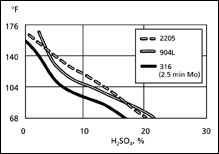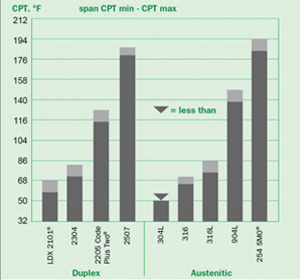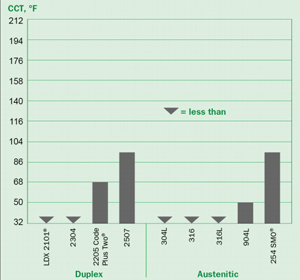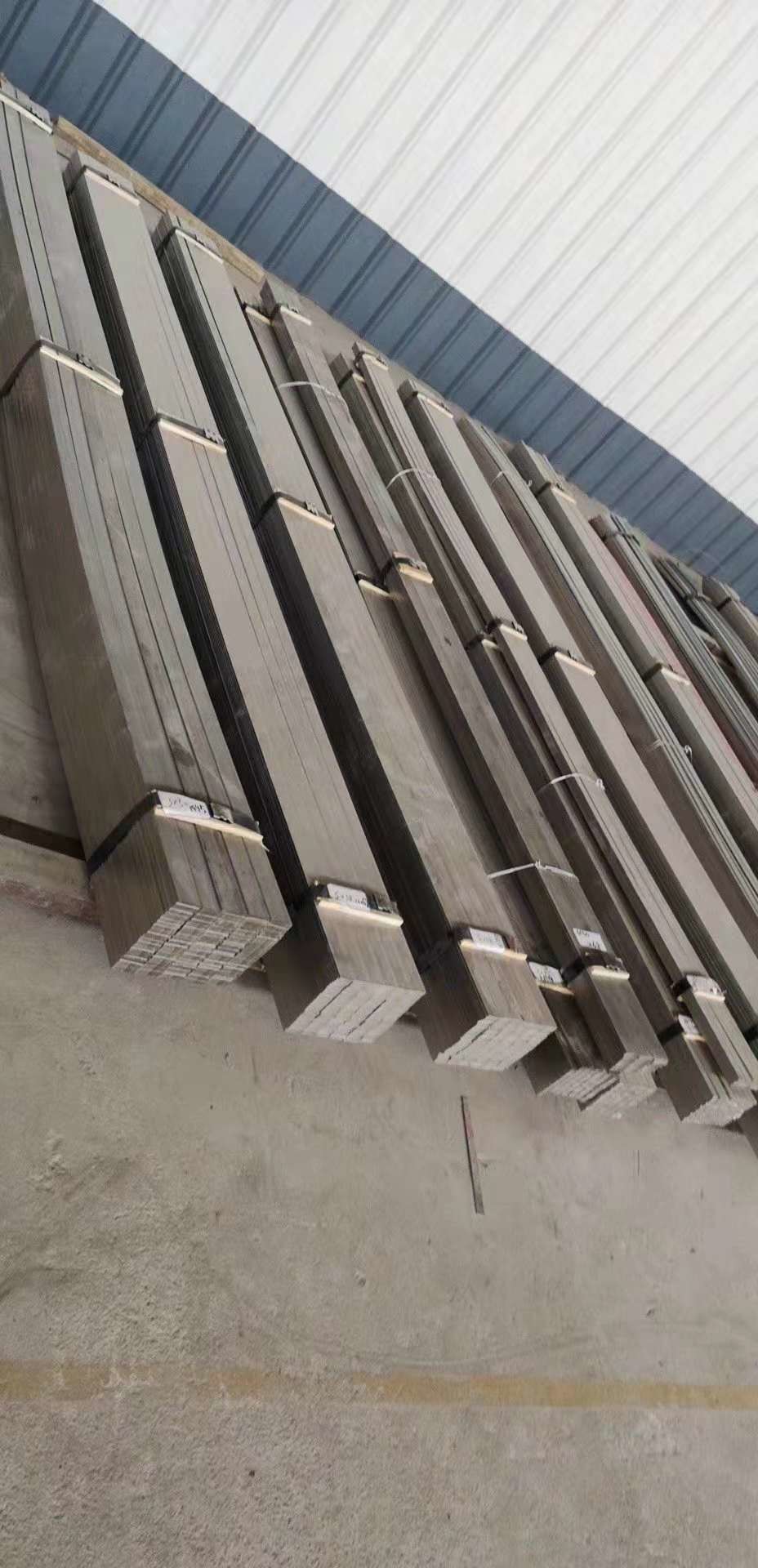JIANGSU MITTEL STEEL INDUSTRIAL LIMITED |
|
Verified Suppliers
|
|
Sandmeyer Steel Company has an extensive inventory of 2205 duplex
stainless steel plate in thicknesses from 3/16" (4.8mm) through 6"
(152.4mm). The yield strength is about twice that of austenitic
stainless steels, thus allowing a designer to save weight and
making the alloy more cost competitive when compared to 316L or
317L.
Available thicknesses for Alloy 2205:
| 3/16" | 1/4" | 5/16" | 3/8" | 1/2" | 5/8" | 3/4" | 7/8" | 1" | 1 1/8" | 1 1/4" | 1 3/8" | 1 1/2" |
|---|---|---|---|---|---|---|---|---|---|---|---|---|
| 4.8mm | 6.3mm | 7.9mm | 9.5mm | 12.7mm | 15.9mm | 19mm | 22.2mm | 25.4mm | 28.6mm | 31.8mm | 34.9mm | 38.1mm |
| 1 5/8" | 1 3/4" | 2" | 2 1/4" | 2 1/2" | 2 3/4" | 3" | 3 1/4" | 3 1/2" | 4" | 5" | 6" | |
| 41.3mm | 44.5mm | 50.8mm | 57.2mm | 63.5mm | 69.9mm | 76.2mm | 82.6mm | 88.9mm | 101.6mm | 127mm | 152.4mm | |
Alloy 2205 (UNS S32305/S31803) is a 22% chromium, 3% molybdenum, 5-6% nickel, nitrogen alloyed duplex stainless steel plate with high general, localized, and stress corrosion resistance properties in addition to high strength and excellent impact toughness.
Alloy 2205 duplex stainless steel plate provides pitting and crevice corrosion resistance superior to 316L or 317L austenitic stainless steels in almost all corrosive media. It also has high corrosion and erosion fatigue properties as well as lower thermal expansion and higher thermal conductivity than austenitic.
for Alloy 2205 (UNS S32205/S31803)
A 22Cr-3Mo Stainless Steel:
Alloy 2205 duplex stainless steel plate is a 22% Chromium, 3% Molybdenum, 5-6% Nickel nitrogen alloyed duplex stainless steel plate with high general, localized and stress corrosion resistance properties in addition to high strength and excellent impact toughness.
Alloy 2205 duplex stainless steel plate provides pitting and crevice corrosion resistance superior to 316L or 317L austenitic stainless steels in almost all corrosive media. It also has high corrosion and erosion fatigue properties as well as lower thermal expansion and higher thermal conductivity than austenitic.
The yield strength is about twice that of austenitic stainless steels. This allows a designer to save weight and makes the alloy more cost competitive when compared to 316L or 317L.
Alloy 2205 duplex stainless steel plate is particularly suitable for applications covering the -50°F/+600°F temperature range. Temperatures outside this range may be considered but need some restrictions, particularly for welded structures.
General Corrosion
Because of its high chromium (22%), molybdenum (3%), and nitrogen
(0.18%) contents, the corrosion resistance properties of 2205
duplex stainless steel plate are superior to that of 316L or 317L
in most environments.
Localized Corrosion Resistance
The chromium, molybdenum, and nitrogen in 2205 duplex stainless
steel plate also provide excellent resistance to pitting and
crevice corrosion even in very oxidizing and acidic solutions.

Isocorrosion Curves 4 mpy (0.1 mm/yr), in sulfuric acid solution containing 2000 ppm
Stress Corrosion Resistance
The duplex microstructure is known to improve the stress corrosion
cracking resistance of stainless steels.
Chloride stress corrosion cracking of austenitic stainless steels can occur when the necessary conditions of temperature, tensile stress, oxygen, and chlorides are present. Since these conditions are not easily controlled, stress corrosion cracking has often been a barrier to utilizing 304L, 316L, or 317L.
Corrosion Fatigue Resistence
Alloy 2205 duplex stainless steel plate combines high strength and
high corrosion resistance to produce high corrosion fatigue
strength. Applications in which processing equipment is subject to
both an aggresively corrosive enviroment and to cycle loading can
benefit from the properties of 2205 duplex stainless steel plate.

Critical Pitting Temperature in 1M NaCl Measured using the Outokumpu Stainless, Inc Pitting Cell

Critical Crevice Corrosion Temperature (CCT) in 10% FeCl3•6H2O
General Corrosion in Wet Process Phosphoric Acids
| Corrosion Rate, ipy | ||||||||
|---|---|---|---|---|---|---|---|---|
| Grade | Solution A, 1401/4F | Solution B, 1201/4F | ||||||
| 2205 | 3.1 | 3.9 | ||||||
| 316L | >200 | >200 | ||||||
| 904L | 47 | 6.3 | ||||||
| Composition, wt% | ||||||||
| P2O5 | HCl | HF | H2SO4 | Fe2O3 | Al203 | SiO2 | CaO | MgO |
| Sol A 54.0 | 0.06 | 1.1 | 4.1 | 0.27 | 0.17 | 0.10 | 0.20 | 0.70 |
| Sol B 27.5 | 0.34 | 1.3 | 1.72 | 0.4 | 0.001 | 0.3 | 0.02 | — |
Stress Corrosion Cracking Resistance
| Boiling | Wick | Boiling | |
|---|---|---|---|
| Grade | 42% MgCl2 | Test | 25% NaCl |
| 2205 | F | P | P |
| 254 SMO® | F | P | P |
| Type 316L | F | F | F |
| Type 317L | F | F | F |
| Alloy 904L | F | P or F | P or F |
| Alloy 20 | F | P | P |
(P = Pass, F = Fail)
Typical Values (Weight %)
| Carbon | Chromium | Nickel | Molybdenum | Nitrogen | Others |
|---|---|---|---|---|---|
| 0.020 | 22.1 | 5.6 | 3.1 | 0.18 | S=0.001 |
| PREN = [Cr%] = 3.3 [Mo%] = 16 [N%] ≥ 34 | |||||
Mechanical Properties at Room Temperature
| ASTM A 240 | Typical | |
|---|---|---|
| Yield Strength 0.2%, ksi | 65 min. | 74 |
| Tensile Strength, ksi | 90 min. | 105 |
| Elongation, % | 25 min. | 30 |
| Hardness RC | 32 max. | 19 |
Tensile Properties at Elevated Temperatures
| Temperature °F | 122 | 212 | 392 | 572 |
|---|---|---|---|---|
| Yield Strength 0.2%, ksi | 60 | 52 | 45 | 41 |
| Tensile Strength, ksi | 96 | 90 | 83 | 81 |
| Temperature °F | 68 | 212 | 392 | 572 | |
|---|---|---|---|---|---|
| Density | lb/in3 | 0.278 | — | — | — |
| Modulus of Elasticity | psi x 106 | 27.6 | 26.1 | 25.4 | 24.9 |
| Linear Expansion (68°F-T) | 10-6/°F | — | 7.5 | 7.8 | 8.1 |
| Thermal Conductivity | Btu/h ft°F | 8.7 | 9.2 | 9.8 | 10.4 |
| Heat Capacity | Btu/lb ft°F | 0.112 | 0.119 | 0.127 | 0.134 |
| Electrical Resistivity | Ωin x 10-6 | 33.5 | 35.4 | 37.4 | 39.4 |
The chemical analysis of 2205 duplex stainless steel plate is optimized to obtain a typical 50 a/ 50 g microstructure after solution annealing treatment at 1900°/1922°F (1040°/1080°C).
The pitting resistance of an austenitic stainless steel can be related directly to alloy composition, where chromium, molybdenum and nitrogen are a weight %. The Pitting Resistance Equivalent Number (PREN) uses the following formula to measure an alloy's relative pitting resistance - the higher the number, the better the pitting resistance.
Forming below 600°F is recommended whenever possible. When hot forming is required, the workpiece should be heated uniformly and worked in the range of 1750 to 2250°F. Alloy 2205 duplex stainless steel plate is quite soft at these temperatures and is readily formed. Above this range, 2205 is subject to hot tearing. Immediately below this range, the austenite becomes substantially stronger than the ferrite and may cause cracking, a particular danger to “cold” edges. Below 1700°F there can be rapid formation of intermetallic phases because of the combination of temperature and deformation. Whenever hot forming is done, it should be followed by a full solution anneal at 1900°F minimum and rapid quench to restore phase balance, toughness, and corrosion resistance. Stress relieving is not required or recommended; however, if it must be performed, the material should receive a full solution anneal at 1900°F minimum, followed by rapid cooling or water quenching.
Alloy 2205 duplex stainless steel plate is readily sheared and cold formed on equipment suited to working stainless steels. However, because of the high strength and rapid work hardening of 2205 duplex stainless steel plate, forces substantially higher than those for austenitic steels are required to cold form it. Also because of the high strength, a somewhat larger allowance must be made for springback.
Alloy 2205 duplex stainless steel plate should be annealed at 1900°F minimum, followed by rapid cooling, ideally by water quenching. This treatment applies to both solution annealing and stress relieving. Stress relief treatments at any lower temperature carry the risk of precipitation of detrimental intermetallic or nonmetallic phases.
With high-speed steel tooling, 2205 duplex stainless steel plate may be machined at the same feeds and speeds as Alloy 316L. When carbide tooling is used, cutting speeds should be reduced by about 20% relative to the speeds for Alloy 316L. Powerful machines and rigid mounting of tools and parts are essential.
Alloy 2205 duplex stainless steel plate possesses good weldability. The goal of welding 2205 is that the weld metal and heat-affected zone (HAZ) retain the corrosion resistance, strength, and toughness of the base metal. The welding of 2205 is not difficult, but it is necessary to design welding procedures that lead to a favorable phase balance after welding and will avoid precipitation of detrimental intermetallic or nonmetallic phases.




